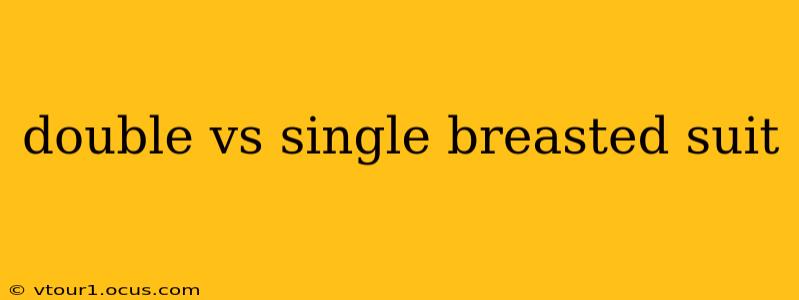Choosing between a double-breasted and a single-breasted suit is a crucial decision for any man building a sophisticated wardrobe. Both styles offer distinct advantages and project different aesthetics, impacting your overall look and feel. This guide delves into the nuances of each, helping you determine which style best suits your personality, body type, and occasion.
What's the Difference Between Double and Single Breasted Suits?
The most obvious difference lies in the buttoning. A single-breasted suit has a single row of buttons, typically two or three, and a simple overlapping front. A double-breasted suit, on the other hand, features a double row of buttons, usually six or more, with wider lapels and a more substantial, structured appearance. This broader front creates a more dramatic silhouette.
Which Suit Style is More Flattering?
This is subjective and depends heavily on your body type.
-
For those with a larger build: A double-breasted suit can often be more flattering. The wider lapels and broader front create a visually slimming effect, drawing the eye outwards and balancing proportions. The structured design can also help conceal a larger midsection.
-
For slimmer builds: A single-breasted suit might be a more suitable choice. The simpler design won't overwhelm a smaller frame. However, a well-tailored double-breasted suit can also work well if the proportions are balanced.
Which Style is More Formal?
Traditionally, the double-breasted suit holds a reputation for greater formality. Its structured silhouette and assertive design convey a sense of power and sophistication, making it a classic choice for high-stakes meetings or formal events. However, modern interpretations of both styles blur these lines somewhat. A well-tailored single-breasted suit in a darker color can also be highly appropriate for formal occasions.
What Occasions Are Best Suited to Each Style?
-
Single-breasted suits: Versatile and adaptable, these suits are suitable for a wide range of occasions, from business meetings and job interviews to weddings and social events. The style lends itself well to both casual and formal settings depending on fabric and accessories.
-
Double-breasted suits: These suits are best suited to more formal occasions. They are a statement piece, ideal for high-profile events, black-tie affairs (when appropriate), or when you want to project an image of authority and confidence.
How Do I Choose the Right Size and Fit?
Proper fit is paramount for both styles. A well-fitting suit, regardless of whether it's single or double-breasted, will enhance your appearance and project a polished image. Ensure the shoulders lie flat, the jacket fits comfortably across the chest and waist without being too tight or too loose, and the sleeves end at the wrist bone. Consider getting your suit professionally tailored for the perfect fit.
What About the Buttoning? Should I Always Button the Bottom Button?
-
Single-breasted: The bottom button is often left undone, particularly on a two-button suit. On a three-button suit, either the bottom or middle button may be left undone, according to preference.
-
Double-breasted: The general rule is to always button the top button on a double-breasted suit, and you may optionally button the bottom button. Never button only the bottom button.
Are Double-Breasted Suits Outdated?
Absolutely not! While they may have experienced periods of less popularity, double-breasted suits have enjoyed numerous revivals throughout history. They remain a classic and timeless style that, when worn correctly, can project sophistication and timeless style. Modern designers frequently incorporate double-breasted suits into their collections, proving their enduring appeal.
What are the Pros and Cons of Each Style?
Single-Breasted Suits:
Pros: Versatile, comfortable, more widely available, generally less expensive.
Cons: Can be less visually impactful than a double-breasted suit.
Double-Breasted Suits:
Pros: Visually striking, can be more slimming, conveys authority and sophistication.
Cons: Can be less comfortable, less versatile, can be more expensive, and may not be as suitable for all body types.
By carefully considering these factors and your own personal style, you can confidently choose the suit style that best complements you and enhances your overall appearance. Remember, the key is to select a suit that is well-tailored and fits you perfectly.
